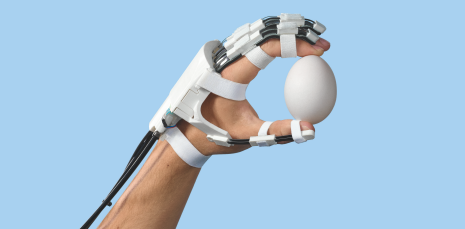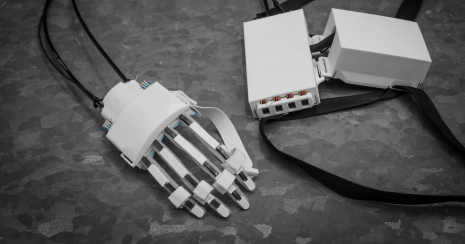A thought-controlled robotic exoskeleton for the hand
September 26, 2016

A robotic hand exoskeleton helps stroke patients integrate rehabilitation exercises into their everyday lives. (credit: Gerber Loesch Photography)
Scientists at ETH Rehabilitation Engineering Laboratory in Switzerland have invented a robotic system that they say could fundamentally change the daily lives of stroke patients.
According to the ETH scientists, one in six people will suffer a stroke in their lifetime; two thirds of those affected suffer from paralysis of the arm. Intensive clinical training, including robot-assisted therapy, can help patients regain a degree of limited control over their arms and hands.
But now Roger Gassert, Professor of Rehabilitation Engineering at ETH Zurich, has a better idea. “My vision is that instead of performing exercises in an abstract situation at the clinic, patients will be able to integrate them into their daily life at home, supported in some cases by a robot” — using an exoskeleton mounted on the hand.
A lightweight exoskeleton that extends the patient’s hand
The problem: existing exoskeletons are heavy, so patients can’t lift their hands, Gassert says, and patients have difficulty feeling objects and exerting the right amount of force. “That’s why we wanted to develop a model that leaves the palm of the hand more or less free, allowing patients to perform daily activities that support not only motor (movement) functions but somatosensory functions as well.”
The initial solution, developed with Professor Jumpei Arata from Kyushu University (Japan), was a mechanism for the finger featuring three overlapping leaf springs. A motor moves the middle spring, which transmits the force to the different segments of the finger through the other two springs. The fingers thus automatically adapt to the shape of the object the patient wants to grasp. But the motors brought the weight of the exoskeleton to 250 grams, which in clinical tests proved too heavy for patients.
The new solution: remove the motors from the hand and fix them to the patient’s back. The force is transmitted to the exoskeleton using a bicycle brake cable. The hand module now weighs slightly less than 120 grams and is strong enough to lift a liter bottle of mineral water.

A hand exoskeleton with motors that can be fixed to the patient’s back: A bicycle brake cable transmits enough force to lift a liter bottle of mineral water. (credit: Stefan Schneller)
Strengthening existing neural connections between brain and hand
Another problem was making sure commands from the brain can reach the extremities after a stroke. “Especially with seriously affected patients, the connection between the brain and the hand is often severely or completely disrupted,” Gassert explains.
The idea is to enable the brain to detect a patient’s intention to move his or her hand and directly pass this information on to the exoskeleton.
Gassert says a number of studies show that it is possible to strengthen existing neural connections between the brain and the hand with regular exercise if the brain can receive somatosensory feedback from the hand when it produces a command to move.
Gassert is using electroencephalography (EEG) and functional near-infrared spectroscopy (fNIRS) to study this. An interaction between the brain and the exoskeleton could lead to a device that is ideally suited for therapy — without requiring brain implants.
Even if the deficits are permanent, a robotic device could still offer vital long-term support.